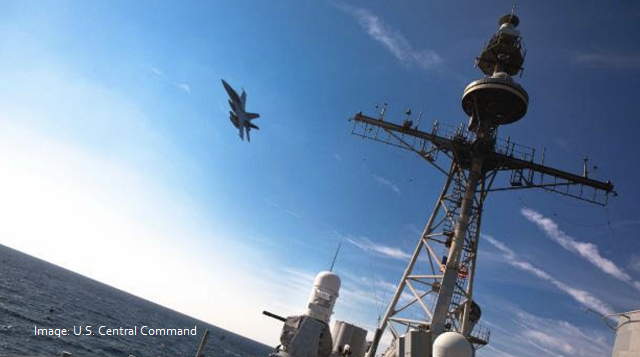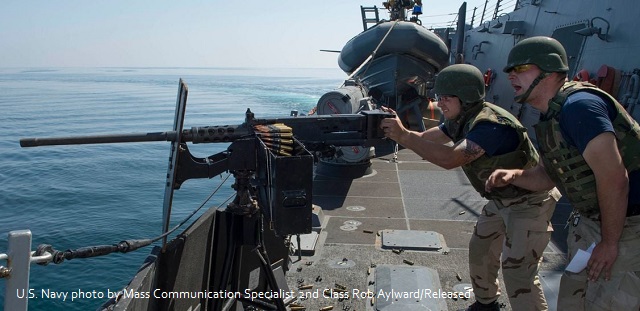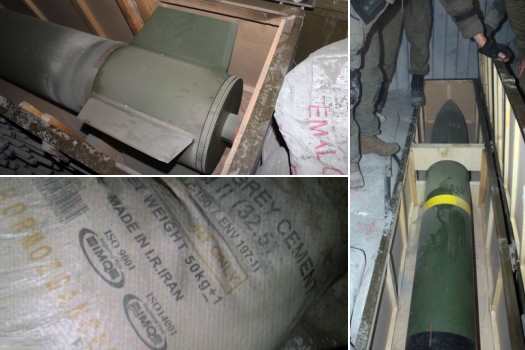
- U.S. forces in the Middle East have shot down at least 50 drones and 11 missiles since the Oct. 17 escalation in attacks by Iran-backed militias, according to a Daily Caller News Foundation tally.
- U.S. troops in Iraq and Syria have come under attack at least 106 times, a Department of Defense official told the DCNF.
- Meanwhile, naval forces in the Red Sea have defended against 46 attack drones and saved commercial shipping vessels from ballistic missiles the Yemen-based Houthi rebel group fired.
U.S. troops in the Middle East have engaged more than 50 drones and at least 11 missiles, including ballistic missiles, fired by Iranian proxy groups, since the Oct. 17 escalation in attacks, according to a Daily Caller News Foundation tally.
The Iran-backed militias conducting drone and missile attacks on U.S. troops in Iraq and Syria and on commercial shipping in the Red Sea have framed their activities as a means of opposing Israel in its war on the Hamas terrorist group in Gaza, and Washington’s alleged underwriting of the conflict that began Oct. 7. In the process of defending against those attacks, U.S. forces have downed dozens of drones and missiles targeting or nearing American personnel, U.S. Central Command (CENTCOM) statements, media reports and claims by the militia groups show.
The Pentagon says it aims to prevent a wider war from cascading across the Middle East and has moved to bolster air defenses at bases throughout the region.
A Department of Defense (DOD) official told the DCNF on Friday afternoon the Pentagon has counted at least 106 attacks on U.S. forces Iraq and Syria since Oct. 17. CENTCOM has confirmed only six drones successfully intercepted during those attacks, but media reports suggest the number could be much higher.
The Islamic Resistance of Iraq, a coalition of various Iran-backed militant groups, through its semi-official Iraq War Media social media channel issued another claim on Friday accompanied by footage of rocket launches.
The first attack took place on Oct. 17, when the U.S. military and coalition forces fended off three explosive-laden drones bearing down on U.S. troops stationed in Iraq in two different incidents, CENTCOM said in a press release. The next day, two sites in Syria hosting American and partner troops came under attack; one of the drones was shot down before it could cause damage, while the other one caused minor injuries to personnel at the al-Tanf coalition garrison.
Kataib Hezbollah, a powerful Iran-backed Iraqi militia, had threatened to attack U.S. military bases with missiles, special forces and drones if the U.S. intervened militarily in support of Israel, Reuters reported.
Rockets and drones pummeled the Ain al-Asad air base near Baghdad later on Oct. 19. On Oct. 23, U.S. troops shot down two more kamikaze drones in Syria with unspecified defensive systems, Pentagon officials confirmed. Rockets rained down at Iraq’s Ain al-Asad again on Oct. 24, Reuters reported, citing two Iraqi security sources.
The Pentagon warned Iran and its proxy militias in the Middle East intended to further escalate conflict by attacking U.S. troops based in the region.
Dozens of troops have sustained minor injures, and one American contractor died during a false alarm.
On Oct. 25, one attack was recorded at a location in northern Syria on Wednesday, The Washington Post reported, citing U.S. officials. Three rockets were aimed at the outpost and one landed inside, although no troops were injured.
The Islamic Resistance in Iraq has claimed dozens of attacks, not all of which have been verified as successful. They continued through November and December.
Christmas day saw the most significant casualty of all the attacks when an explosive drone apparently crashed into Erbil Air Base in Iraq, wounding two American service members and leaving a third in critical condition, the Pentagon said. In retaliation, President Joe Biden ordered airstrikes on “Kataib Hezbollah and affiliated groups focused specifically on UAV activities,” damaging facilities used to make drones and likely killing or wounding multiple militants.
It was the fourth round of airstrikes Biden ordered on facilities associated with the militant groups and Iran’s Islamic Revolutionary Guard Corps, which oversees Tehran’s proxy operations, since Oct. 27.
Additionally, U.S. and coalition forces have defended bases as militants were planning or in the process of conducting strikes, recording casualties.
Separately, U.S. Naval forces in the Red Sea have downed at least 46 attack drones and 11 missiles the Iran-backed Houthi rebels in Yemen have launched, according to a DCNF tally. The USS Carney guided-missile destroyer intercepted three land-attack cruise missiles and eight drones that appeared intended to strike Israel on Oct. 19, USNI News reported, citing a preliminary Pentagon after-action report.
Since then, CENTCOM has documented 23 attacks on commercial shipping in the Red Sea, according to a statement. U.S. destroyers and fighter jets from the USS Dwight D. Eisenhower aircraft carrier scrambled to respond.
In the latest incident, Houthi rebels on four small boats fired small arms and crew-served guns at U.S. helicopters while attempting to board a Maersk container ship early Sunday, the first time the Pentagon has confirmed Houthi militants directly targeted American military personnel. U.S. helicopters fired back, killing militants and sinking three of the skifs, the military said.
Saturday night, the Gravely shot down two more anti-ship ballistic missiles fired by the Houthis, according to CENTCOM.
The Pentagon is documenting attacks on international shipping on a case-by-case basis, the DOD official told the DCNF.
“Often times if multiple munitions are fired in quick succession, that would count as once ‘incident.’ However, it really depends on the timing and sequence of events during a period of time,” the official said.
U.S. warships downed drones twice in November and responded to an attempted strike on commercial ship with anti-ship ballistic missiles, CENTCOM has said. Incidents increased in frequency in December; on one occasion, the USS Carney shot down 14 attack drones that came at the destroyer in a wave, without any evidence of warship nearby.
Dec. 3 proved an especially tense day as the UUS Carney guided-missile destroyer responded to three separate distress calls as the commercial ships came under attack from an onslaught of drones and ballistic missiles from areas occupied by the Iran-backed militant group, U.S. Central Command (CENTCOM) said in a statement. In the process of rendering support to the ships, the Carney downed three Houthi drones but CENTCOM said it was too early to determine whether a U.S. Navy vessel was also a target.
“These attacks represent a direct threat to international commerce and maritime security. They have jeopardized the lives of international crews representing multiple countries around the world. We also have every reason to believe that these attacks, while launched by the Houthis in Yemen, are fully enabled by Iran,” CENTCOM said in the statement.
U.S. naval assets downed a dozen suicide drones, three anti-ship ballistic missiles and two land-based cruise missiles the Houthis fired toward the Red Sea over a 10-hour period on Dec. 26, the military said in a statement.
In a statement, the Houthi military spokesperson affirmed the group’s “continued support and support of the Palestinian people as part of their religious, moral and humanitarian duty” and reiterated intentions to attack any commercial vessel tied to Israeli owners or destined for Israel.
Shipping in the Red Sea has decreased dramatically to the Houthi threat, as successful strikes have sparked fires on board merchant vessels and tankers, while U.S. forces continue to take down missiles.
The Pentagon announced Operation Prosperity Guardian, a multinational task force aimed at safeguarding shipping through the critical waterway, on Dec. 18. Major freight companies say they still plan to reroute around Cape of Good Hope, CNN reported.
So far, the Pentagon has not confirmed whether the Houthis aimed for any drones heading directly for U.S. warships to impact on those ships, reportedly to avoid provoking further tensions as the region is simmering over the war between Israel and Gaza. The Biden administration has also refrained from directly targeting Houthi launch sites.
“President Biden’s perceived weakness by our enemies is leading to escalating attacks against our servicemembers and lawful commercial shipping. These attacks will continue until these terrorists understand that their actions will have severe consequences.” Rep. Mike Rogers of Alabama, who chairs the House Armed Services Committee, said in a statement.
AUTHOR
Investigative reporter, defense.
RELATED ARTICLES:
US-Led Coalition To Defend Shipping Against Houthi Attacks Doesn’t Hold Water, Experts Say
US Troops Kill Houthi Militants In Red Sea Firefight After Rebels Attempt To Board Commercial Ship
EDITORS NOTE: This Daily Caller column is republished with permission. ©All rights reserved.
All content created by the Daily Caller News Foundation, an independent and nonpartisan newswire service, is available without charge to any legitimate news publisher that can provide a large audience. All republished articles must include our logo, our reporter’s byline and their DCNF affiliation. For any questions about our guidelines or partnering with us, please contact licensing@dailycallernewsfoundation.org.



